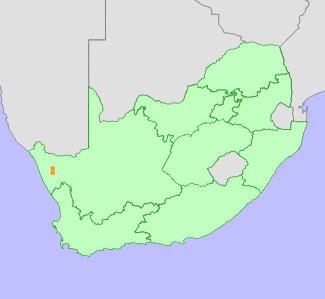|
Scientific Name | Conophytum violaciflorum Schick & Tischer |
Higher Classification | Dicotyledons |
Family | AIZOACEAE |
Synonyms | Conophytum anjametae de Boer, Conophytum geometricum Lavis |
National Status |
Status and Criteria | Vulnerable A4cd |
Assessment Date | 2021/12/10 |
Assessor(s) | A.J. Young, P.G. Desmet, I. Ebrahim, D. Guo, A. Harrower, L. Jabar, L. Knoetze, C. Rodgerson, P.C.V. Van Wyk & N.N. Mhlongo |
Justification | This succulent species is endemic to the Northern Cape province of South Africa where it is only recorded from three localities with an extent of occurrence (EOO) and area of occupancy (AOO) of 16 km2. The dwarf succulents that comprise this genus have been increasingly targeted by illegal collection in recent years and the vast majority of species are in high demand by collectors. The population of this species is in decline due to illegal collection for the international trade in ornamental succulents since 2019. Illegal collection is likely to increase as there has been a dramatic increase in the number of species and volume of plants targeted since 2019 including many from the immediate area. The continued threat of illegal collection is therefore regarded as extremely high for this particular species. The restricted geographic distribution and immediate vicinity to an urban area renders the species highly susceptible to further very rapid declines. A decline of between 80 and 95% of the population is very likely within the next three generations (90 years). Climate change will also contribute towards a population decline of 72% by 2080. It therefore qualifies as Critically Endangered under criterion A4. |
Distribution |
Endemism | South African endemic |
Provincial distribution | Northern Cape |
Range | This species is endemic to the Northern Cape province of South Africa where it is only found in three locations within a restricted geographic range. |
Habitat and Ecology |
Major system | Terrestrial |
Major habitats | Namaqualand Klipkoppe Shrubland |
Description | This dwarf succulent species is endemic to the Namaqualand Hardeveld bioregion of the Succulent Karoo biome. It occurs on quartz scree patches and rocks usually exposed to full sun.
This species has a generation length of 30 years. It is expected to be sensitive to the impacts of climate change as it does not disperse and while adapted to arid conditions, is dependent on limited seasonal rainfall. Species in the genus are sensitive to long periods of drought. Drought related mortality has been observed for other closely related taxa within the genus. |
Threats |
| This species has been highly sought after by collectors with more than a thousand plants removed illegally from habitat since 2019. It is highly likely to continue to be targeted in coming years. Its range-restricted distribution lies in the immediate vicinity of a major urban area which makes the taxon high susceptible to very rapid decline in the population. As a result a population decline of up to 95% is suspected over three generations (90 years).
There is no decline in habitat quality for this taxon as inferred by changes in vegetation cover determined from changes in Enhanced Vegetation Index (EVI) between 1984 and 2018 using Landsat data (Venter et al. 2020). While it is not possible to model the response of this taxon to climate change due to its restricted distribution, the average loss to climate change for 15 more widely distributed Conophytum species occurring within the same region is used as an indication of likely impact to this species. Climate models for the likely emission scenarios where emissions stay at present day levels (RCP 2.6) (Hausfather and Peters 2020) and worst case scenarios where emissions continue to increase during the 21st century (RCP 8.5) indicate that there will be a loss of suitable bioclimatic envelope of between 72% and 99% by 2080 for Conophytum taxa within the region. Species in this genus have limited dispersal ability and migration to suitable habitats elsewhere is regarded as highly unlikely.
Residential and commercial developments are a potential localised threat to this species. |
Population |
This succulent is locally very abundant. There are no formal estimates of population size for this species but there are likely between 50,000 and 150,000 mature individuals. The population is in decline due to illegal collection for the ornamental succulent plant trade. At least 1,500 plants have been removed from habitat between 2019 and the end of 2021 based on confiscation records, with many more having likely been removed but not intercepted by law enforcers.
|
Population trend | Decreasing |
Assessment History |
Taxon assessed |
Status and Criteria |
Citation/Red List version | | Conophytum violaciflorum Schick & Tischer | VU D2 | 2017.1 | | Conophytum violaciflorum Schick & Tischer | Least Concern | Raimondo et al. (2009) | |
Bibliography |
Hammer, S.A. 1993. The genus Conophytum: A conograph. Succulent Plant Publications, Pretoria.
Hausfather, Z. and Peters, G.P. 2020. Emissions - the 'business as usual' story is misleading. Nature 577(618-620).
Opel, M.R. 2004. The rediscovery of Crassula alcicornis. Haseltonia 10:38-40.
Raimondo, D., von Staden, L., Foden, W., Victor, J.E., Helme, N.A., Turner, R.C., Kamundi, D.A. and Manyama, P.A. 2009. Red List of South African Plants. Strelitzia 25. South African National Biodiversity Institute, Pretoria.
Snijman, D.A. 2013. Plants of the Greater Cape Floristic Region 2: The extra Cape flora. Strelitzia 30. South African National Biodiversity Institute, Pretoria.
|
Citation |
| Young, A.J., Desmet, P.G., Ebrahim, I., Guo, D., Harrower, A., Jabar, L., Knoetze, L., Rodgerson, C., Van Wyk, P.C.V. & Mhlongo, N.N. 2021. Conophytum violaciflorum Schick & Tischer. National Assessment: Red List of South African Plants version 2024.1. Accessed on 2025/12/13 |
 Comment on this assessment
Comment on this assessment


